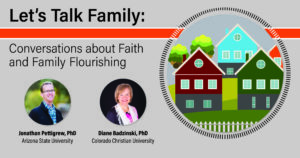Column: Let’s Talk Family: Conversations about Faith and Family Flourishing
Column entry: Let’s Talk about Love
By Jonathan Pettigrew, PhD, Arizona State University; Diane Badzinski, PhD, Colorado Christian University
Column Description: Let’s Talk Family: Conversations about Faith and Family Flourishing is a monthly column offering a space to consider research-based, biblically-sound practices for family communication. We all have families. And we all experience messy family communication from time to time. Our column focuses on what works and doesn’t work for helping families be a little less messy and a lot more rewarding. Please join the conversation.
March 2023 | February 2023 | January 2023
February 2023
Let’s Talk about Love
We just celebrated Valentine’s Day, and as Australian singer John Paul Young reminds us, “Love is in the Air.” So let’s talk about love, shall we?
What did you do this year to show love to those you hold dear?
How much did it cost? According to the National Retail Association, the average American spends $175.00 to $210.00 to express love on Valentine’s Day. Sound pricey?
Some see February 14 as a commercialized “Hallmark Holiday,” putting pressure on all to purchase expensive cards and elaborate gifts. We don’t go that far. Instead, we see Valentine’s Day as a great reminder to shower love on others.
Unfortunately, showing love only on Valentine’s Day is like cleaning the bathroom once a year—it would stink! Research on relationships confirms that daily, consistent displays of love are way more important than a single grandiose gesture.
So, how can we express love to our family members all year long?
How about listening well?
James 1:19 says everyone should be quick to listen and slow to speak. Proverbs 18:13 says it is our folly and shame to answer before listening. Whoa—it’s so easy to stick our foot in our mouth when we assume we know what others will say. We can avoid such folly by truly listening. Listening well helps others feel heard and understood, which makes them feel loved.
A metaphor for listening well is, well, a well. Proverbs 20:5 says that “a person of understanding” draws out the deep thoughts of our hearts. Have you ever drawn water from a well? Most haven’t.
So, imagine the following:
You have a bucket attached to a rope as you stand before a hole in the ground. The rope is prickly and thick, long and heavy. There is no pulley system or hand crank on this well, just a circumference of stones around a two-foot opening. You lower a heavy wooden bucket down into the water deep below. You let the bucket sink into the water and then draw it up. It fills about a gallon and weighs about 8 pounds.
Now, you start to pull. If you want the maximum amount of water, you can’t exactly let the rope pull against the top edge of the well because the bucket will bounce along the well as you draw it up, losing water—the very thing you are trying to draw out. Instead, you have to reach out over the well and hand-over-hand pull the rope up.
You must be slow, patient, methodical, and consistent—the very practices needed to draw out the deep plans, thoughts, feelings, and motivations of another person. Sounds like a Valentine’s-level kind of connection to us!
Listening well is a great gift for our loved ones. It breeds the kind of connection and intimacy that we imagine for Valentine’s Day. It’s costly, but not expensive. It’s not hard, but it takes practice. And it takes intentionality. Listening well and drawing out the depths of a lover’s heart doesn’t happen by accident. Listening is critical for connecting. Connecting is essential for relationships.
So let’s get a little more specific. Next time you want to listen well, here’s a tip: be an ACE listener.
- Attention: Be fully present. Put down the phone or the book. Listen with your whole body—face your conversation partner, make eye contact, and maintain an open posture.
- Clarify: Seek understanding. If you don’t understand something, ask. “What do you mean when you say. . . ?” “I’ve never heard something described that way. Can you give me an example?” An easy phrase to remember and practice is simply “Tell me more.” Or try paraphrasing. These questions and actions signal that you are paying attention and want to understand.
- Encourage: Encouragement gives “courage” —literally, “heart or spirit”—to the other. On Valentine’s Day we offer heart-shaped candies and make heart-shaped cookies as expressions of love. We can also give “heart” by offering words of encouragement, saying things like, “I love hearing from you” or “I want to know what you think” or “Please share how that made you feel.” You encourage others by letting them know that they can share anything—successes and mistakes—with you. You encourage connection.
Who did you “offer heart” to this Valentine’s Day? Were you an ACE listener?
To join the conversation, let us know what you’ve found that works well to draw others out, show love, and celebrate your relationships. We’d appreciate hearing from you.
– Diane and Jonathan
* The views of any CCSN columnists are their own, and do not necessarily represent the views of the CCSN. We invite and embrace a wide range of views and critiques on important communication and cultural issues from a Christian perspective. The CCSN is a community of Jesus followers who study communication. We do not support or promote a particular social, political, or denominational agenda.
References
Winter, Mike, “How Much Americans are Planning to Spend on Valentine’s Day,” CNBC (February 7, 2022), https://www.cnbc.com/2022/02/06/how-much-americans-are-planning-to-spend-on-valentines-day.html

